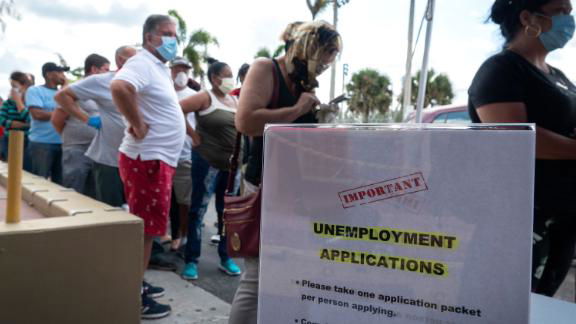Unemployment claims rise for second week in a row

WASHINGTON, DC — In yet another sign that the economic recovery is teetering in a resurgence of coronavirus cases, the number of Americans filing first-time unemployment claims rose for the second week in a row.
Some 1.4 million people filed for initial jobless claims last week, up 12,000 from the prior week’s revised level, which was the first increase in 16 weeks, according to the Department of Labor.
The news came on the same day as a separate report showed that the US economy contracted at a 32.9% annual rate from April through June, its worst drop on record. These both added to concerns that the economy is faltering.
They also come as Congress debates whether to provide more stimulus to the nation, including extending enhanced unemployment benefits and another round of direct payments to Americans.
“The fact that initial jobless claims have risen for a second week is worrying and underscores that the nascent consumption recovery is at risk,” said Moody’s Investors Service’s Vice President Madhavi Bokil. “The economic recovery is also at risk from the prospect of reduced fiscal support to households and businesses experiencing income and revenue losses.”
On an unadjusted basis, 1.2 million people filed first-time claims, down 171,000 from the week before. The seasonal adjustments are traditionally used to smooth out the data, but that has tended to have the opposite effect during the pandemic.
Continued claims, which count workers who have filed for at least two weeks in a row, stood at 17 million for the week ending July 18, up 867,000 from the prior week’s revised level. This was the first weekly increase since late May. These seasonally adjusted claims peaked in May at nearly 25 million.
In addition to those filing traditional unemployment claims, nearly 830,000 people in all 50 states filed for first-time pandemic unemployment assistance last week, down more than 106,000 from the week before. More than 12.4 million claimed continued pandemic benefits across 46 states for the week ending July 11, down nearly 767,000 from the prior week.
Pandemic unemployment claims data, however, is very volatile from week to week because it may include backlogged filings.
The pandemic program was created by Congress in March to respond to the coronavirus outbreak. It provides temporary benefits to workers who typically aren’t eligible for payments, including freelancers, independent contractors, the self-employed and certain people affected by coronavirus. It expires at the end of the year.
In total, 30.2 million Americans claimed jobless benefits in an array of programs for the week ending July 11, down 1.6 million from the prior week.
Congress debate over extending the $600 weekly enhancement
The weakening economic outlook comes as Congress bickers over whether to extend the $600 weekly enhancement that lawmakers passed in March to cushion Americans forced to give up their jobs because of pandemic-fueled lockdowns. The boost officially expires this Friday, but most unemployed people have already received their last payments.
House Democrats want to continue the $600 supplement into early next year, saying the economy remains too weak and jobs are still scarce.
But Senate Republicans and the White House are concerned that such a generous enhancement will deter people from returning to work and hinder the economy recovery. When combined with state benefits, the extra $600 meant that two-thirds of workers were making more on unemployment than their did in wages, according to an estimate by University of Chicago researchers.
Instead, GOP lawmakers are looking to cut the benefit to $200 a week for two months and then shift to having state and federal payments replace 70% of lost wages through the rest of the year.
Economists, however, say the federal supplement has helped prop up the economy as the virus rages across the nation, and withdrawing it too soon could stymie the recovery.
“The looming expiration of federal unemployment benefits without a clear-cut replacement threatens a chunk of consumer spending power that has sustained households and made its way back into the economy,” said Greg McBride, Bankrate.com’s chief financial analyst.
Although the federal government was footing the bill for the $600 supplement, states are still exhausting their unemployment trust funds. Some 10 states have borrowed nearly $17.2 billion from the federal government to pay their share of jobless benefits, which typically lasts 26 weeks.
The jobless are guaranteed to get their weekly payment, regardless of whether the state has to take a loan from the federal government. It’s not unusual for states to borrow during tough economic times.
